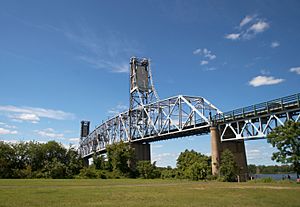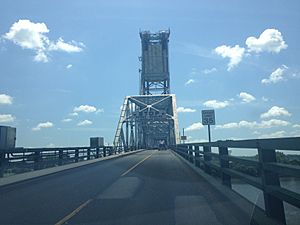Burlington–Bristol Bridge facts for kids
Quick facts for kids Burlington–Bristol Bridge |
|
|---|---|

The Burlington Bristol Bridge from Burlington, New Jersey
|
|
| Coordinates | 40°04′53″N 74°52′10.5″W / 40.08139°N 74.869583°W |
| Carries | 2 lanes of |
| Crosses | Delaware River |
| Locale | Bristol Township, Pennsylvania and Burlington, New Jersey |
| Official name | Burlington–Bristol Bridge |
| Owner | Burlington County Bridge Commission |
| Maintained by | Burlington County Bridge Commission |
| ID number | 3000002 (NJ) 097101999100010 (PA) |
| Characteristics | |
| Design | vertical lift bridge |
| Material | steel |
| Total length | 2,301 feet (701.3 m) |
| Width | 20 feet (6.1 m) |
| Longest span | 540 feet (165 m) |
| Clearance below | 61 feet when closed at high tide to 135 feet (41.1 m) when open |
| History | |
| Construction begin | April 1930 |
| Construction end | May 2, 1931 |
| Construction cost | $1.5 million |
| Opened | May 2, 1931 |
| Statistics | |
| Daily traffic | 25,241 (1992) |
| Toll | $4.00 (cash), $3.00 (E-ZPass) northbound |
The Burlington–Bristol Bridge is a special kind of bridge called a vertical-lift bridge. This means its middle section can go up and down! It crosses the Delaware River, connecting Burlington, New Jersey with Bristol Township, Pennsylvania. This important bridge helps cars travel between the two states.
Construction of the bridge started on April 1, 1930. It officially opened to traffic on May 2, 1931. The bridge carries two main roads: New Jersey Route 413 and Pennsylvania Route 413.
About the Bridge
The Burlington–Bristol Bridge is managed by the Burlington County Bridge Commission. It has two lanes for cars. The total length of the bridge is about 2,301 feet (701 meters). That's longer than seven football fields! The part of the bridge that lifts up is about 540 feet (165 meters) long.
How the Lift Span Works
The middle part of the bridge lifts up to let tall boats pass underneath. This is done using two very large concrete slabs. These slabs are a bit heavier than the lift span itself. When the bridge needs to open, motors start the slabs moving downwards. Then, gravity does most of the work, pulling the slabs down and lifting the bridge section up.
In 2016, new traffic lights and gates were added at both ends of the bridge. These help stop cars safely when the bridge is about to lift.
Traffic and Tolls
When the bridge lifts for a boat, traffic can get very busy. Cars often back up on Keim Boulevard, which is the road leading to the bridge from U.S. Route 130.
There are tollbooths on the bridge. Drivers pay a fee to cross into Pennsylvania. You can pay with cash or use an electronic system called E-ZPass. Using E-ZPass usually makes the toll cheaper.
Future Plans
People have talked about building new bridges in this area. However, most of these ideas would mean extending the access ramps to US Route 130. This would unfortunately require tearing down some old, historic buildings and a large industrial park near the bridge.


